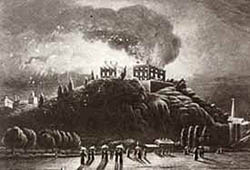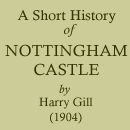< Previous | Contents | Next >

Nottingham Castle ablaze in 1831.
In 1831 the rejection of the Reform Bill by the House of Lords was the occasion of serious rioting, when much damage was done to property in Nottingham and the neighbourhood. The Castle, being situate outside the municipal area, and belonging to a Peer who was known to be opposed to the Bill, was marked out for special attention, and was burnt and sacked by the mob. The following graphic description of the burning is copied from Mrs. Gilbert’s “Recollections of Old Nottingham":— “The spirit of discontent which broke out in open riot in Nottingham, at the House of Lords’ rejection of the Reform Bill, had been smouldering for two or three years, so that when the news was brought down by Pickford, the great carrier, and by the mail coach passengers, the mob, swelled by roughs arriving for the forthcoming races, was ripe for every form of mischief. . . . On the morning of the memorable Sunday, October 9th, hundreds assembled before the White Lion, awaiting the arrival of the mail. As the coach drove up a passenger remarked that the reformers in London were beating to arms. That was enough. The crowd, with wild cries, rushed at the dwellings of supposed anti-reformers and perpetrated lawless deeds. The Mayor—Mr. William Wilson—left the service at Castle Gate Chapel and hastened to the multitude. While exhorting them to disperse and refrain from violence he himself was struck and injured. The Riot Act was then read; the constables were, however, unable to seize the chief offenders or make much impression on the moving mob. Monday morning was comparatively peaceful, so that the Mayor did not think it necessary to prohibit the public meeting in the Market Place he had convened at the request of the principal townsmen. The speakers, from a waggon in the centre of the space, addressed a dense and orderly mass; but the fringe of the assembly consisted of the lowest and most despicable characters. These renewing the disturbances of the previous day, the authorities, ever loth to do so, found the moment had come to use extreme measures. A troop of the 15th Hussars was called out from the Park Barracks—for Nottingham was for many years a military station. They kept dispersing the mob. One section, however, eluded their vigilance. Making their way Sneinton-wards, they proceeded to Colwick, the original Notts, seat of Lord Byron’s ancestors. Entering the mansion, they began to lay about with the railings they had torn from Notintone Place, Sneinton; they ripped up the pictures, smashed everything they could, and finally set fire to a portion of the building. Mr. Musters was away from home; Mrs. Musters—Lord Byron’s Mary Ann Chaworth—and a French lady, a visitor, made their escape to the shrubbery. Here in evening dress Mrs. Musters received that shock to the system which terminated her life five weeks later at Wiverton Hall, the dower-house of the Chaworths.
"The mob now turned homewards, intoxicated with success and with the wine they had broached from the Colwick Hall cellars. ‘To the Castle!’ was now the cry, and thither the mass surged on.
"The details; so far, I had from my father and others. Now for my own personal recollections. On that 10th of October I was in bed about eight o’clock, but not asleep: the roar outside was too terrible and persistent for even infancy’s slumbers. Presently someone lifted me up—presumably a servant—and throwing a shawl over me, held me at the window, I can never forget that sight. Beneath, a dense black mass of human beings, more like wild beasts, shrieking and howling; above, columns of smoke through which after a while the flames penetrated, lighting up St. James’s Church, Standard Hill, and the whole neighbourhood. Athwart that deafening roar came the sound of crackling and falling timbers; by and by a delicious odour was wafted in our direction from the burning cedar wood, of which costly material the panels of many of the rooms were made. It seems the place was completely gutted; the beautiful tapestry, which escaped the conflagration at the beginning, was torn down by the miscreants and sold to bystanders at three shillings per yard. One impressive sight was the molten lead pouring down in lurid streams from the roof of that noble mansion.
"Fortunate was it that the Castle was untenanted when the mob attacked it; the lodge-keeper, after useless resistance, had to flee for his life.”

A beautifully wrought lead cistern, bearing the arms and crest of the builder, seems to have escaped the general destruction, and is now preserved in the grounds.
In August of the following year (1832) a special jury, at Leicester Assizes, awarded the Duke of Newcastle a sum of £21,000 as compensation for the destruction of the Castle.
